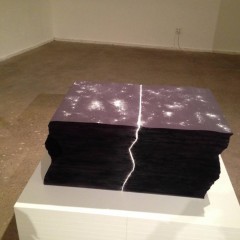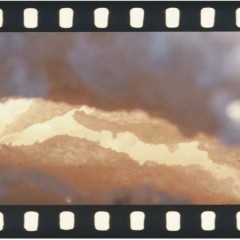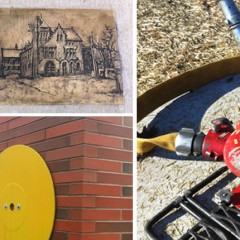A report by Steve Kimbrough
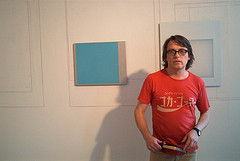
Kevin Finklea in front of a nuanced blue painting, Eagle Gallery, London.
Philadelphia artist and friend of Artblog Kevin Finklea has four paintings on show at the Eagle Gallery in London. Each painting is on a solid board, either of plexiglass or MDF. No framing necessary. Each painting consists of a rectangle of darker color set against a lighter background. The rectangles are each off center to the left, in reference to British driving habits. In two of the paintings the rectangles are biased up, and in two, down. [Ed note: to see more of Kevin’s works, check out his page at Minus Space.]
Three of the rectangles are variously off-white, darker than their surrounding backgrounds. The fourth is a variety of blue, or torquoise. Shading — color variation that amounts to texture, within the rectangles, indeed within the backgrounds — is subtle. While it is not George Bush’s job to nuance (or so he says), Kevin Flinklea’s paintings are replete with it.
The artist was in the gallery when I was there, so I asked the inevitable question of what the work is about. (I was reminded of my MBA students who are wont to inquire about the “take-away” for everything they encounter. Here in London this conjures a definite pungence.) Kevin makes two points. First, the paintings are to be comtemplated. Second, the paintings are deliberately open to multiple interpretations. He used a very nice word here, beginnng with “v” I think, but I forget it. The key to both points is that the appearance of the paintings changes–subtly, with nuance–as the ambient light changes. He showed me with the lights in the room, and he’s right. It is easy to imagine that a day or a year would bring even richer treats.
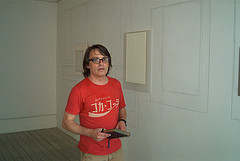
Kevin Finklea in front of his paintings, Eagle Gallery, London.
A familiar theme (trick?) recurs in all art, or rather throughout all forms of art: systematic, intended ambiguity. That’s why multiple interpretations are possible, even after we know everything we might possibly learn about the work. So Flinklea’s work is grounded in this tradition. A question, then: Is it the art we contemplate or the thoughts occasioned by engaging the art? Nothing urgent here; it could be both.
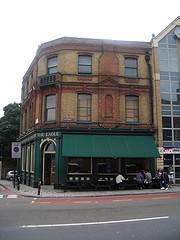
The Eagle Pub. The gallery’s upstairs.
The Eagle Gallery is itself a remarkable institution. It is upstairs from the Eagle pub, reported to be the original “gastropub” in London, and the inspiration for Philadelphia’s own Standard Tap. (The food’s tonier at the Eagle.) To hear gallery proprietoress Emma Hill tell the story, Eagle Gallery was founded 15 years ago when the Eagle Pub was founded, because the owners made cheap space available to her, thinking it would be good marketing for the pub. It seems they were right. At least the pub has prospered, and the gallery has achieved very good things. And it is, after all, a very fine thing to have lunch at the pub —- with a pint of Eagle nonetheless -— and then to engage in contemplation occasioned by nuanced ambiguity in the art upstairs.
[Ed note: What did our beer-imbibing reporter eat at the gastropub? “I had chicken cooscoos. Cooscoos is all the rage in Paris, so I wanted to taste and compare. It was fine. Different than in Paris, but quite good.” Steve’s been in Paris for a while. You can see his photos — including a self-portrait influenced by seeing a Cindy Sherman exhibit — at my flickr set.
And stay tuned, by the way, for more London reporting. This time, from Kevin Finklea, who promised to tell us about what he’s been checking out while installing his show at Eagle.]
BENDING SPACE: Andrew Bick, Julia Farrer, Kevin Finklea, on view until July 28. Emma Hill Fine Art, The Eagle Gallery, 159 Farringdon Road, London EC1R 3AL, T: 020 7833 2674, F: 020 7 624 6597, Wed-Friday 11-6, Saturday 11-4, Tube: Farringdon.
–Steve Kimbrough is no stranger to artblog, being not only one of its guardian angels but also married to Roberta. When he’s not writing about art you can find him plying his trade as professor at Penn’s Wharton School where his key words include: decision support systems; electronic commerce; artificial intelligence and computational rationality; logic modeling; evolutionary computation (including genetic algorithms and genetic programming).


